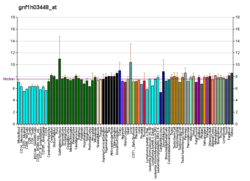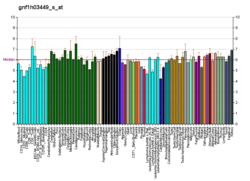ADAMTS10
| ADAMTS10 | |||||||||||||||||||||||||||||||||||||||||||||||||||
|---|---|---|---|---|---|---|---|---|---|---|---|---|---|---|---|---|---|---|---|---|---|---|---|---|---|---|---|---|---|---|---|---|---|---|---|---|---|---|---|---|---|---|---|---|---|---|---|---|---|---|---|
| Identifiers | |||||||||||||||||||||||||||||||||||||||||||||||||||
| Aliases | ADAMTS10, ADAM-TS10, ADAMTS-10, WMS, WMS1, ADAM metallopeptidase with thrombospondin type 1 motif 10 | ||||||||||||||||||||||||||||||||||||||||||||||||||
| External IDs | OMIM: 608990; MGI: 2449112; HomoloGene: 81940; GeneCards: ADAMTS10; OMA:ADAMTS10 - orthologs | ||||||||||||||||||||||||||||||||||||||||||||||||||
| |||||||||||||||||||||||||||||||||||||||||||||||||||
| |||||||||||||||||||||||||||||||||||||||||||||||||||
| |||||||||||||||||||||||||||||||||||||||||||||||||||
| |||||||||||||||||||||||||||||||||||||||||||||||||||
| |||||||||||||||||||||||||||||||||||||||||||||||||||
| Wikidata | |||||||||||||||||||||||||||||||||||||||||||||||||||
| |||||||||||||||||||||||||||||||||||||||||||||||||||
A disintegrin and metalloproteinase with thrombospondin motifs 10 is an enzyme that in humans is encoded by the ADAMTS10 gene.[5]
This gene belongs to the ADAMTS (a disintegrin and metalloproteinase domain with thrombospondin type-1 motifs) family of zinc-dependent proteases. ADAMTS proteases are complex secreted enzymes containing a prometalloprotease domain of the reprolysin type attached to an ancillary domain with a highly conserved structure that includes at least one thrombospondin type 1 repeat. They have been demonstrated to have important roles in connective tissue organization, coagulation, inflammation, arthritis, angiogenesis and cell migration. The product of this gene plays a major role in growth and in skin, lens, and heart development. It is also a candidate gene for autosomal recessive Weill-Marchesani syndrome.[5]
References
- ^ a b c GRCh38: Ensembl release 89: ENSG00000142303 – Ensembl, May 2017
- ^ a b c GRCm38: Ensembl release 89: ENSMUSG00000024299 – Ensembl, May 2017
- ^ "Human PubMed Reference:". National Center for Biotechnology Information, U.S. National Library of Medicine.
- ^ "Mouse PubMed Reference:". National Center for Biotechnology Information, U.S. National Library of Medicine.
- ^ a b "Entrez Gene: ADAMTS10 ADAM metallopeptidase with thrombospondin type 1 motif, 10".
Further reading
- Tang BL (2001). "ADAMTS: a novel family of extracellular matrix proteases". Int. J. Biochem. Cell Biol. 33 (1): 33–44. doi:10.1016/S1357-2725(00)00061-3. PMID 11167130.
- Faivre L, Dollfus H, Lyonnet S, et al. (2004). "Clinical homogeneity and genetic heterogeneity in Weill-Marchesani syndrome". Am. J. Med. Genet. A. 123 (2): 204–7. doi:10.1002/ajmg.a.20289. PMID 14598350. S2CID 13600027.
- Apte SS (2004). "A disintegrin-like and metalloprotease (reprolysin type) with thrombospondin type 1 motifs: the ADAMTS family". Int. J. Biochem. Cell Biol. 36 (6): 981–5. doi:10.1016/j.biocel.2004.01.014. PMID 15094112.
- Faivre L, Mégarbané A, Alswaid A, et al. (2002). "Homozygosity mapping of a Weill-Marchesani syndrome locus to chromosome 19p13.3-p13.2". Hum. Genet. 110 (4): 366–70. doi:10.1007/s00439-002-0689-3. PMID 11941487. S2CID 10463979.
- Strausberg RL, Feingold EA, Grouse LH, et al. (2003). "Generation and initial analysis of more than 15,000 full-length human and mouse cDNA sequences". Proc. Natl. Acad. Sci. U.S.A. 99 (26): 16899–903. Bibcode:2002PNAS...9916899M. doi:10.1073/pnas.242603899. PMC 139241. PMID 12477932.
- Brandenberger R, Wei H, Zhang S, et al. (2005). "Transcriptome characterization elucidates signaling networks that control human ES cell growth and differentiation". Nat. Biotechnol. 22 (6): 707–16. doi:10.1038/nbt971. PMID 15146197. S2CID 27764390.
- Fu GK, Wang JT, Yang J, et al. (2005). "Circular rapid amplification of cDNA ends for high-throughput extension cloning of partial genes". Genomics. 84 (1): 205–10. doi:10.1016/j.ygeno.2004.01.011. PMID 15203218.
- Somerville RP, Jungers KA, Apte SS (2005). "Discovery and characterization of a novel, widely expressed metalloprotease, ADAMTS10, and its proteolytic activation". J. Biol. Chem. 279 (49): 51208–17. doi:10.1074/jbc.M409036200. PMID 15355968.
- Charrier L, Yan Y, Driss A, et al. (2005). "ADAM-15 inhibits wound healing in human intestinal epithelial cell monolayers". Am. J. Physiol. Gastrointest. Liver Physiol. 288 (2): G346–53. doi:10.1152/ajpgi.00262.2004. PMID 15358598.
- Dagoneau N, Benoist-Lasselin C, Huber C, et al. (2005). "ADAMTS10 mutations in autosomal recessive Weill-Marchesani syndrome". Am. J. Hum. Genet. 75 (5): 801–6. doi:10.1086/425231. PMC 1182109. PMID 15368195.
External links
- GeneReviews/NIH/NCBI/UW entry on Weill-Marchesani Syndrome
- The MEROPS online database for peptidases and their inhibitors: M12.235
- Human ADAMTS10 genome location and ADAMTS10 gene details page in the UCSC Genome Browser.
 | This article on a gene on human chromosome 19 is a stub. You can help Wikipedia by expanding it. |
- v
- t
- e



















